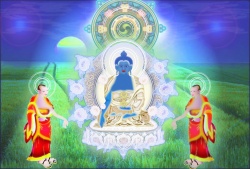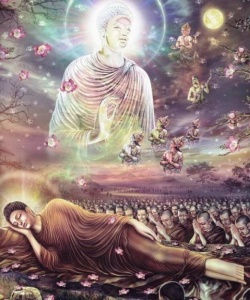Difference between revisions of "Quantum Buddhism: Dancing in Emptiness - Reality Revealed at the Interface of Quantum Physics and Buddhist Philosophy"
m (Text replace - "result" to "result") |
|||
| (15 intermediate revisions by 4 users not shown) | |||
| Line 1: | Line 1: | ||
[[File:Achala3774.jpg|thumb|250px|]] | [[File:Achala3774.jpg|thumb|250px|]] | ||
<poem> | <poem> | ||
| − | + | 1. {{Wiki|Quantum}} [[Buddhism]]? | |
| − | An overview of the current vigorous [[debate]] concerning the relationship between the [[intellectual]] arenas of the Eastern [[religions]] and [[philosophy]] and the discoveries of the modern {{Wiki|physics}}; in particular the polarisation between the viewpoints of the now invalidated {{Wiki|materialism}} as argued for by writers such as {{Wiki|Daniel Dennett}} and {{Wiki|Richard Dawkins}}. The [[extraordinary]] evidence which is now incontrovertibly indicating the deep connection between the {{Wiki|quantum}} [[realm]] and the [[phenomenon]] of [[consciousness]] is briefly surveyed within the context of perspectives of the [[Yogacara]] ([[Yogic]] practitioners), [[Chittamatra]] ([[Mind-Only]]) and [[Madhyamaka]] ([[Middle-Way]]) [[Buddhist]] [[philosophies]]. Initial evidence for a deep connection between these worldviews and the evidence of modern {{Wiki|quantum physics}} is [[offered]]. In particular the {{Wiki|quantum}} evidence that [[consciousness]] comprises the [[nature]] of the {{Wiki|quantum}} [[realm]] is viewed in the [[light]] of the similar [[Mind-Only]] (Chittamatra-Yogacara) assertion: | + | An overview of the current vigorous [[debate]] concerning the relationship between the [[intellectual]] arenas of the Eastern [[religions]] and [[philosophy]] and the discoveries of the {{Wiki|modern}} {{Wiki|physics}}; in particular the polarisation between the viewpoints of the now invalidated {{Wiki|materialism}} as argued for by writers such as {{Wiki|Daniel Dennett}} and {{Wiki|Richard Dawkins}}. The [[extraordinary]] {{Wiki|evidence}} which is now incontrovertibly indicating the deep connection between the {{Wiki|quantum}} [[realm]] and the [[phenomenon]] of [[consciousness]] is briefly surveyed within the context of perspectives of the [[Yogacara]] ([[Yogic]] practitioners), [[Chittamatra]] ([[Mind-Only]]) and [[Madhyamaka]] ([[Middle-Way]]) [[Buddhist]] [[philosophies]]. Initial {{Wiki|evidence}} for a deep connection between these worldviews and the {{Wiki|evidence}} of {{Wiki|modern}} {{Wiki|quantum physics}} is [[offered]]. In particular the {{Wiki|quantum}} {{Wiki|evidence}} that [[consciousness]] comprises the [[nature]] of the {{Wiki|quantum}} [[realm]] is viewed in the [[light]] of the similar [[Mind-Only]] (Chittamatra-Yogacara) [[assertion]]: |
[[Nothing]], such as [[atoms]] and so on, [[exist]] externally, As anything other than [[cognition]]. | [[Nothing]], such as [[atoms]] and so on, [[exist]] externally, As anything other than [[cognition]]. | ||
| Line 9: | Line 9: | ||
This is clearly echoed by many assertions within {{Wiki|quantum physics}} such as the following by one of the founding fathers of {{Wiki|quantum theory}}, Erwin Schrödinger: | This is clearly echoed by many assertions within {{Wiki|quantum physics}} such as the following by one of the founding fathers of {{Wiki|quantum theory}}, Erwin Schrödinger: | ||
| − | [[Mind]] has erected the [[objective]] outside [[world]] … out of its own stuff. | + | [[Mind]] has erected the [[objective]] outside [[world]] … out of its [[own]] stuff. |
[[File:3 shwedagon WQ'.jpg|thumb|250px|]] | [[File:3 shwedagon WQ'.jpg|thumb|250px|]] | ||
| − | An initial survey of such remarkable correspondences is presented. The question is presented. If so many of the founding fathers of {{Wiki|quantum theory}} came to the | + | An initial survey of such remarkable correspondences is presented. The question is presented. If so many of the founding fathers of {{Wiki|quantum theory}} came to the conclusion that the [[primary]] [[nature]] of the process of [[reality]] was [[mind]] or [[consciousness]], why is there still an overwhelming {{Wiki|materialist}} prejudice underlying the general [[Western]] and [[intellectual]] climate? |
| − | The general dividing lines between those who see significant parallels and deep similarities between {{Wiki|Eastern philosophies}} and other who pour scorn and opprobrium upon such ideas are looked into. An initial indication that the weight of evidence now clearly supports the former [[view]] is indicated. The particular suitability of [[Buddhist]] [[philosophies]] for | + | The general dividing lines between those who see significant parallels and deep similarities between {{Wiki|Eastern philosophies}} and other who pour scorn and opprobrium upon such [[ideas]] are looked into. An initial indication that the {{Wiki|weight}} of {{Wiki|evidence}} now clearly supports the former [[view]] is indicated. The particular suitability of [[Buddhist]] [[philosophies]] for comparison with {{Wiki|modern}} {{Wiki|physics}} is outlined and some of the important contributions within this area is outlined and evaluated. An initial [[discussion]] of the significance of the core [[Buddhist]] [[philosophical]] notion of `[[emptiness]]`, the lack of [[inherent]] [[self]] [[existence]] in all [[phenomena]], is provided, together with significant {{Wiki|evidence}} that this crucial [[Buddhist]] notion has deep significance for [[understanding]] the [[nature]] of {{Wiki|quantum}} [[Wikipedia:paradox|paradoxes]]. In a recent issue of New [[Scientist]] for instance we read that precise {{Wiki|quantum}} [[experiences]] clearly suggest that: |
| − | `we now have to face the possibility that there is [[nothing]] inherently real about the properties of an [[object]] that we [[measure]]. In other words [[measuring]] those properties is what brings them into existence.` | + | `we now have to face the possibility that there is [[nothing]] inherently real about the properties of an [[object]] that we [[measure]]. In other words [[measuring]] those properties is what brings them into [[existence]].` |
| − | The recently performed experiments that have demonstrated lack of inherent [[reality]] of the measured properties involve testing a special [[formula]] at the {{Wiki|quantum}} level; if the `numbers add up` then `we have to abandon the [[idea]] of an [[objective]] reality`. When the experiments were performed the numbers did add up and the | + | The recently performed experiments that have demonstrated lack of [[inherent]] [[reality]] of the measured properties involve testing a special [[formula]] at the {{Wiki|quantum}} level; if the `numbers add up` then `we have to abandon the [[idea]] of an [[objective]] [[reality]]`. When the experiments were performed the numbers did add up and the conclusion that has to be drawn, according to one of the {{Wiki|quantum}} {{Wiki|physicists}} involved, is that: |
[[File:3.jpg|thumb|250px|]] | [[File:3.jpg|thumb|250px|]] | ||
Rather than passively observing it, we in fact create [[reality]]. | Rather than passively observing it, we in fact create [[reality]]. | ||
| − | These {{Wiki|quantum}} discoveries were clearly prefigured in the central [[doctrines]] of both [[Madhyamika]] and [[Chittamatra]] [[Buddhist]] [[philosophies]]. The | + | These {{Wiki|quantum}} discoveries were clearly prefigured in the central [[doctrines]] of both [[Madhyamika]] and [[Chittamatra]] [[Buddhist]] [[philosophies]]. The conclusion that the properties of {{Wiki|matter}} are not inherently real immediately projects us into the domain of one of the central [[Buddhist]] [[Madhyamika]] [[insights]] concerning the [[nature]] of the [[reality]] that may be correctly attributed to the [[objects]] of our [[experience]]: |
| − | [[Phenomena]] are [[empty]] of a certain mode of [[existence]] called `inherent existence`, `objective existence`;, or `natural existence`; | + | [[Phenomena]] are [[empty]] of a certain mode of [[existence]] called `[[inherent existence]]`, `[[objective]] [[existence]]`;, or `natural [[existence]]`; |
| − | This [[insight]] into the lack of `inherent existence` or [[svabhava]] in [[Sanskrit]], is the hallmark of [[emptiness]], or [[dependent origination]], which highlights the inescapable fact that at all levels of [[reality]] there is [[nothing]] which is completely independent of other [[phenomena]]. This is one of the most important {{Wiki|conclusions}} arrived at by the [[Madhyamaka]]. The [[Chittamatra]], or [[Mind-Only]], school of [[Mahayana Buddhism]] complements the [[Madhyamika]] perspective with its [[insight]] that it is the [[mind]] that is interdependently instrumental in bringing [[phenomena]] into [[existence]]: | + | This [[insight]] into the lack of `[[inherent existence]]` or [[svabhava]] in [[Sanskrit]], is the hallmark of [[emptiness]], or [[dependent origination]], which highlights the inescapable fact that at all levels of [[reality]] there is [[nothing]] which is completely {{Wiki|independent}} of other [[phenomena]]. This is one of the most important {{Wiki|conclusions}} arrived at by the [[Madhyamaka]]. The [[Chittamatra]], or [[Mind-Only]], school of [[Mahayana Buddhism]] complements the [[Madhyamika]] {{Wiki|perspective}} with its [[insight]] that it is the [[mind]] that is interdependently instrumental in bringing [[phenomena]] into [[existence]]: |
| − | ..all these various [[appearances]], Do not [[exist]] as sensory [[objects]] which are other than [[consciousness]]. Their arising is like the [[experience]] of [[self]] [[knowledge]]. All [[appearances]], from indivisible particles to vast [[forms]], are [[mind]]. | + | ..all these various [[appearances]], Do not [[exist]] as sensory [[objects]] which are other than [[consciousness]]. Their [[arising]] is like the [[experience]] of [[self]] [[knowledge]]. All [[appearances]], from indivisible {{Wiki|particles}} to vast [[forms]], are [[mind]]. |
[[File:Achalai22.jpg|thumb|250px|]] | [[File:Achalai22.jpg|thumb|250px|]] | ||
| − | We are therefore immediately confronted with a remarkably precise confluence of perspectives between {{Wiki|quantum physics}} and the Yogacara-Chittamatra and [[Madhyamaka]] [[Buddhist]] analyses of the [[nature]] of [[reality]]; a meeting of viewpoints which concerns the innermost [[nature]] of [[reality]]. As the reader will discover during the course of this [[book]] the resonances between {{Wiki|quantum physics}} and [[Buddhist]] [[philosophical]] analysis go much deeper that mere [[superficial]] coincidences. It will become clearly apparent that the [[Buddhist]] adepts of at least two and half centuries ago had insights into the [[nature]] of [[reality]] which adumbrated the discoveries of modern {{Wiki|physics}}. | + | We are therefore immediately confronted with a remarkably precise confluence of perspectives between {{Wiki|quantum physics}} and the Yogacara-Chittamatra and [[Madhyamaka]] [[Buddhist]] analyses of the [[nature]] of [[reality]]; a meeting of viewpoints which concerns the innermost [[nature]] of [[reality]]. As the reader will discover during the course of this [[book]] the resonances between {{Wiki|quantum physics}} and [[Buddhist]] [[philosophical]] analysis go much deeper that mere [[superficial]] coincidences. It will become clearly apparent that the [[Buddhist]] {{Wiki|adepts}} of at least two and half centuries ago had [[insights]] into the [[nature]] of [[reality]] which adumbrated the discoveries of {{Wiki|modern}} {{Wiki|physics}}. |
2. Interconnected Lightness of [[Being]] | 2. Interconnected Lightness of [[Being]] | ||
| − | In a recent work [[offering]] simplified explanations of cutting edge theories of {{Wiki|physics}} about the [[ultimate nature]] of the [[universe]] the popular mass consumption [[science]] writer Marcus Chown claims that the everyday [[phenomenon]] of partial reflection by glass, the fact that in many situations a glass window will produce a faint reflection of someone looking through it, tells us: | + | In a recent work [[offering]] simplified explanations of cutting edge theories of {{Wiki|physics}} about the [[Wikipedia:Absolute (philosophy)|ultimate]] [[nature]] of the [[universe]] the popular {{Wiki|mass}} consumption [[science]] writer Marcus Chown claims that the everyday [[phenomenon]] of partial {{Wiki|reflection}} by glass, the fact that in many situations a glass window will produce a faint {{Wiki|reflection}} of someone looking through it, tells us: |
…something profound and shocking about fundamental [[reality]]. It is telling you that the [[Universe]], at its deepest level, is founded on randomness and unpredictability, the capricious role of a dice – that, ultimately, things happen for no [[reason]] at all | …something profound and shocking about fundamental [[reality]]. It is telling you that the [[Universe]], at its deepest level, is founded on randomness and unpredictability, the capricious role of a dice – that, ultimately, things happen for no [[reason]] at all | ||
| − | We shall see in this chapter that this claim is false; in fact the [[phenomenon]] of the ‘face in the window’ tells a very different story. | + | We shall see in this [[chapter]] that this claim is false; in fact the [[phenomenon]] of the ‘face in the window’ tells a very different story. |
| − | This chapter investigates the [[phenomenon]] of entanglement and the implications of the patterns of {{Wiki|behaviour}} which [[exist]] at the {{Wiki|quantum}} level. Along the way it provides a detailed yet non-mathematical explanation of the [[nature]] and functioning of the {{Wiki|quantum}} wave [[function]]. | + | This [[chapter]] investigates the [[phenomenon]] of entanglement and the implications of the patterns of {{Wiki|behaviour}} which [[exist]] at the {{Wiki|quantum}} level. Along the way it provides a detailed yet non-mathematical explanation of the [[nature]] and functioning of the {{Wiki|quantum}} wave [[function]]. |
| − | The | + | The conclusion of the analysis indicates the remarkable interconnection between the [[Buddhist]] [[Avatamsaka Sutra]]: |
[[File:Aka.jpg|thumb|250px|]] | [[File:Aka.jpg|thumb|250px|]] | ||
| − | There is a wonderful net which has been | + | There is a wonderful net which has been hung by some cunning artificer in such a [[manner]] that it stretches out indefinitely in all [[directions]]. In accordance with the extravagant {{Wiki|tastes}} of [[deities]], the artificer has hung a single glittering [[jewel]] at the net’s every node, and since the net itself is [[infinite]] in [[dimension]], the [[jewels]] are [[infinite]] in number. There hang the [[jewels]], glittering like {{Wiki|stars}} of the first magnitude, a wonderful [[sight]] to behold. If we now {{Wiki|arbitrarily}} select one of these [[jewels]] for inspection and look closely at it, we will discover that in its polished surface there are reflected all the other [[jewels]] in the net, [[infinite]] in number. Not only that, but each of the [[jewels]] reflected in this one [[jewel]] is also {{Wiki|reflecting}} all the other [[jewels]], so that the process of {{Wiki|reflection}} is [[infinite]]. |
and Marcus Chown's observation that: | and Marcus Chown's observation that: | ||
| − | Everything in the [[Universe]] is in some weird [[sense]] linked, since all particles – those out of which you are made and those which constitute the [[most distant]] galaxy – were once together in the same state in the Big Bang. The ‘spooky’ connectedness of particles, in violation of the [[cosmic]] speed limit, was cited by {{Wiki|Einstein}} as a [[reason]] why {{Wiki|quantum theory}} had to be wrong. Unfortunately for {{Wiki|Einstein}}, careful experiments carried out in laboratories since the early 1980s have confirmed that particles can indeed {{Wiki|communicate}} with each other instantaneously. | + | Everything in the [[Universe]] is in some weird [[sense]] linked, since all {{Wiki|particles}} – those out of which you are made and those which constitute the [[most distant]] {{Wiki|galaxy}} – were once together in the same [[state]] in the [[Big Bang]]. The ‘spooky’ connectedness of {{Wiki|particles}}, in {{Wiki|violation}} of the [[cosmic]] {{Wiki|speed}} limit, was cited by {{Wiki|Einstein}} as a [[reason]] why {{Wiki|quantum theory}} had to be wrong. Unfortunately for {{Wiki|Einstein}}, careful experiments carried out in laboratories since the early 1980s have confirmed that {{Wiki|particles}} can indeed {{Wiki|communicate}} with each other instantaneously. |
| − | Exactly like photons orchestrating the dance of the [[phenomenon]] of partial reflection! | + | Exactly like photons orchestrating the [[dance]] of the [[phenomenon]] of partial {{Wiki|reflection}}! |
| − | 3. Why the Quantum? | + | 3. Why the {{Wiki|Quantum}}? |
| − | John Wheeler, one of the great {{Wiki|physicists}} of the twentieth century, indicated that the solution to the question ‘why the {{Wiki|quantum}}?’ might contain the solution to the question of [[existence]] itself: | + | John Wheeler, one of the great {{Wiki|physicists}} of the twentieth century, indicated that the {{Wiki|solution}} to the question ‘why the {{Wiki|quantum}}?’ might contain the {{Wiki|solution}} to the question of [[existence]] itself: |
[[File:336-1-0.jpg|thumb|250px|]] | [[File:336-1-0.jpg|thumb|250px|]] | ||
…eventually we will have an answer to the question ‘How come the {{Wiki|quantum}}?’ And to the companion question, ‘How come [[existence]]?’ | …eventually we will have an answer to the question ‘How come the {{Wiki|quantum}}?’ And to the companion question, ‘How come [[existence]]?’ | ||
| − | According to Wheeler, then, the answer to the question concerning the {{Wiki|quantum}} [[nature]] of [[reality]] might contain the answer to the question which the [[philosopher]] Heidegger considered to be the most important question for [[philosophy]]; ‘why is there something rather than [[nothing]]?’ The confrontation between the everyday [[world]] and the {{Wiki|quantum}} [[world]] leads us to the very limits of what we can [[know]] about [[reality]]. And according to Wheeler the solution to the question regarding why the [[world]] has a {{Wiki|quantum}} basis will provide an [[insight]] into the [[nature]] of [[existence]] itself. This is, indeed, an [[extraordinary]] possibility which should be sought at all cost. | + | According to Wheeler, then, the answer to the question concerning the {{Wiki|quantum}} [[nature]] of [[reality]] might contain the answer to the question which the [[philosopher]] [[Wikipedia:Martin Heidegger|Heidegger]] considered to be the most important question for [[philosophy]]; ‘why is there something rather than [[nothing]]?’ The confrontation between the everyday [[world]] and the {{Wiki|quantum}} [[world]] leads us to the very limits of what we can [[know]] about [[reality]]. And according to Wheeler the {{Wiki|solution}} to the question regarding why the [[world]] has a {{Wiki|quantum}} basis will provide an [[insight]] into the [[nature]] of [[existence]] itself. This is, indeed, an [[extraordinary]] possibility which should be sought at all cost. |
| − | This chapter investigates the inplications of the double slit experiment for our understanding of the [[nature]] of the realationship of 'matter' and '[[consciousness]]'. The [[ultimate nature]] of [[reality]] can only be of the [[nature]] of [[consciousness]]. But more precisely the [[ultimate nature]] is indicated by the [[Buddhist]] {{Wiki|concept}} of [[Emptiness]]: | + | This [[chapter]] investigates the inplications of the double slit experiment for our [[understanding]] of the [[nature]] of the realationship of '{{Wiki|matter}}' and '[[consciousness]]'. The [[Wikipedia:Absolute (philosophy)|ultimate]] [[nature]] of [[reality]] can only be of the [[nature]] of [[consciousness]]. But more precisely the [[Wikipedia:Absolute (philosophy)|ultimate]] [[nature]] is indicated by the [[Buddhist]] {{Wiki|concept}} of [[Emptiness]]: |
| − | The Heisenberg Uncertainty Principle, which accounts for the fact that {{Wiki|quantum}} entities can ‘hover’ between [[existence]] and nonexistence, is certainly, but counter-intuitively, the aspect of {{Wiki|quantum}} functioning which allows the [[phenomena]] of the [[universe]] to [[function]] coherently. And, as we have seen, the [[Buddhist]] {{Wiki|concept}} of [[Emptiness]], which describes the [[ultimate]] [[metaphysical]] [[nature]] at the [[heart]] of the process of [[reality]], maps precisely onto the {{Wiki|ontological}} structure of the Heisenberg Uncertainty Principle. It seems, then, that we can answer Wheeler’s question ‘Why the Quantum?’ with Nagarjuna’s answer: | + | The Heisenberg {{Wiki|Uncertainty Principle}}, which accounts for the fact that {{Wiki|quantum}} entities can ‘hover’ between [[existence]] and [[Wikipedia:Existence|nonexistence]], is certainly, but counter-intuitively, the aspect of {{Wiki|quantum}} functioning which allows the [[phenomena]] of the [[universe]] to [[function]] coherently. And, as we have seen, the [[Buddhist]] {{Wiki|concept}} of [[Emptiness]], which describes the [[ultimate]] [[metaphysical]] [[nature]] at the [[heart]] of the process of [[reality]], maps precisely onto the {{Wiki|ontological}} {{Wiki|structure}} of the Heisenberg {{Wiki|Uncertainty Principle}}. It seems, then, that we can answer Wheeler’s question ‘Why the {{Wiki|Quantum}}?’ with [[Nagarjuna’s]] answer: |
For those for whom [[emptiness]] is possible, | For those for whom [[emptiness]] is possible, | ||
| Line 69: | Line 69: | ||
4. What's the Matter with Matter? | 4. What's the Matter with Matter? | ||
[[File:3405994.jpg|thumb|250px|]] | [[File:3405994.jpg|thumb|250px|]] | ||
| − | Matter does not [[exist]]; or, to be more precise, {{Wiki|quantum physics}} has clearly shown that the {{Wiki|concept}} of | + | Matter does not [[exist]]; or, to be more precise, {{Wiki|quantum physics}} has clearly shown that the {{Wiki|concept}} of ‘{{Wiki|matter}}’ as understood within pre-quantum {{Wiki|physics}} or ‘classical’ {{Wiki|physics}}, the {{Wiki|physics}} from Renee {{Wiki|Descartes}}’ [[time]] (17th century) down to the early twentieth century, does not [[exist]]. At the turn of the twentieth century the comfortable [[world]] of classical {{Wiki|physics}} began to look less solid than had previously been [[thought]] and subsequently the classical notion of ‘{{Wiki|matter}}’ can no longer be validly connected with any [[existent]] [[entity]] within the [[universe]]. |
| − | In this chapter we review the development the discoveries which showed that {{Wiki|Cartesian}} solid extended matter, conceived of as [[being]] independent of [[consciousness]], does not [[exist]]. | + | In this [[chapter]] we review the [[development]] the discoveries which showed that {{Wiki|Cartesian}} solid extended {{Wiki|matter}}, [[conceived]] of as [[being]] {{Wiki|independent}} of [[consciousness]], does not [[exist]]. |
| − | The chapter concludes: | + | The [[chapter]] concludes: |
| − | All of the {{Wiki|quantum}} [[phenomena]] that we have explored in this overview display a behavioural profile which is completely at odds with any kind of notion that anybody ever had concerning independently [[existing]], [[objective]] matter. However, we have seen occasions when the employment of the term | + | All of the {{Wiki|quantum}} [[phenomena]] that we have explored in this overview display a behavioural profile which is completely at odds with any kind of notion that anybody ever had concerning {{Wiki|independently}} [[existing]], [[objective]] {{Wiki|matter}}. However, we have seen occasions when the employment of the term ‘{{Wiki|matter}}’ actually undermines the [[insights]] of {{Wiki|quantum theory}} by introducing an inappropriate ‘classical’ {{Wiki|flavour}} into the fluid, evanescent [[appearance]] of {{Wiki|quantum}} [[reality]]. We have also seen that seminal experiments clearly indicate that {{Wiki|quantum}} [[elements]] have modes of interacting and modes of [[being]] which are completely at variance with classical {{Wiki|matter}}. The question remains – Why do {{Wiki|physicists}} still refer to ‘{{Wiki|matter}}’ as if it were valid to [[conceive]] of {{Wiki|matter}} as having classical [[attributes]] clearly negated by the discovery of the [[nature]] of {{Wiki|quantum}} [[reality]]? For, as the early [[Buddhist]] contemplative-ilosophers clearly knew, such an aspect of [[reality]] is an [[illusion]], as the following [[assertion]] by the eleventh century [[Kadampa]] [[Buddhist]] {{Wiki|adept}} [[Dromtonpa]] indicates: |
| − | Now I shall cast to the winds concepts of solid [[objects]] with mass. | + | Now I shall cast to the [[winds]] [[Wikipedia:concept|concepts]] of solid [[objects]] with {{Wiki|mass}}. |
| − | 5. Quantum [[Emptiness]] | + | 5. {{Wiki|Quantum}} [[Emptiness]] |
[[File:217106.jpg|thumb|250px|]] | [[File:217106.jpg|thumb|250px|]] | ||
| − | This chapter takes as its starting point the following two quotes, the first from contemporary {{Wiki|quantum}} physicist the second from an important first century [[Buddhist]] [[philosopher]]: | + | This [[chapter]] takes as its starting point the following two quotes, the first from contemporary {{Wiki|quantum}} {{Wiki|physicist}} the second from an important first century [[Buddhist]] [[philosopher]]: |
| − | {{Wiki|Electrons}} passing through this apparatus, in so far as we are able to fathom the matter, do not take route h and do not take route s and do not take both of these routes and do not take neither of these routes; and the trouble is that those four possibilities are simply all of the [[logical]] possibilities… [iv] | + | {{Wiki|Electrons}} passing through this apparatus, in so far as we are able to fathom the {{Wiki|matter}}, do not take route h and do not take route s and do not take both of these routes and do not take neither of these routes; and the trouble is that those four possibilities are simply all of the [[logical]] possibilities… [iv] |
| − | - David Z Albert (twentieth century physicist) | + | - David Z Albert (twentieth century {{Wiki|physicist}}) |
| − | It’s [[character]] is neither [[existent]], nor non-existent, | + | It’s [[character]] is neither [[existent]], nor {{Wiki|non-existent}}, |
| − | Nor both [[existent]] and non-existent, nor neither. | + | Nor both [[existent]] and {{Wiki|non-existent}}, nor neither. |
Centrists should [[know]] true [[reality]] | Centrists should [[know]] true [[reality]] | ||
That is free from these four possibilities. | That is free from these four possibilities. | ||
- [[Bhavaviveka]] (1st century [[Madhyamika]]) | - [[Bhavaviveka]] (1st century [[Madhyamika]]) | ||
| − | This chapter [[logically]] and precisely shows that the description of the [[existence]] of the electron and the characterization of [[reality]] by [[Bhavaviveka]] are identical. Pursuing this line of enquiry with [[philosophical]] rigor it is possible to show that the central [[Buddhist]] [[Madhyamika]] {{Wiki|concept}} of ‘[[emptiness]]’ is precisely descriptive of the [[nature]] of the wavefunction, this [[nature]] can be characterised as ‘neither [[existent]], nor non-existent, nor both [[existent]] and non-existent, nor neither’ which is a [[Madhyamika]] formulation for [[emptiness]]. | + | This [[chapter]] [[logically]] and precisely shows that the description of the [[existence]] of the {{Wiki|electron}} and the characterization of [[reality]] by [[Bhavaviveka]] are [[identical]]. Pursuing this line of enquiry with [[philosophical]] rigor it is possible to show that the central [[Buddhist]] [[Madhyamika]] {{Wiki|concept}} of ‘[[emptiness]]’ is precisely descriptive of the [[nature]] of the wavefunction, this [[nature]] can be characterised as ‘neither [[existent]], nor {{Wiki|non-existent}}, nor both [[existent]] and {{Wiki|non-existent}}, nor neither’ which is a [[Madhyamika]] formulation for [[emptiness]]. |
| − | [[Madhyamika]] reasonings revealing the [[empty]] [[nature]] of [[phenomena]] are presented. The [[Madhyamika]] chariot deconstruction which demonstrates the method of showing the lack of inherent [[existence]] of [[phenomena]] is presented followed by the ‘[[neither one nor many]]’ demonstration of the [[illusory]] [[nature]] of [[phenomena]]. These are supported by the [[Madhyamika]] analysis of the possibility of the [[existence]] of ‘partless | + | [[Madhyamika]] reasonings revealing the [[empty]] [[nature]] of [[phenomena]] are presented. The [[Madhyamika]] [[chariot]] deconstruction which demonstrates the method of showing the lack of [[inherent]] [[existence]] of [[phenomena]] is presented followed by the ‘[[neither one nor many]]’ demonstration of the [[illusory]] [[nature]] of [[phenomena]]. These are supported by the [[Madhyamika]] analysis of the possibility of the [[existence]] of ‘partless {{Wiki|particles}}’. All this leads to the [[Madhyamaka]] ‘{{Wiki|quantum}}’ conclusion that all [[phenomena]] lack [[inherent]] [[existence]]. These are contrasted with similar [[views]] of {{Wiki|quantum}} {{Wiki|physicists}} such a Lee Smolin who suggests {{Wiki|quantum physics}} shows that there are no ‘things’ but only ‘{{Wiki|processes}}; in [[view]] of this the [[Madhyamika]] ‘[[diamond]] slivers’ {{Wiki|reasoning}} is presented in [[order]] to demonstrate the impossibility of inherently real [[cause and effect]] {{Wiki|processes}}. |
[[File:220d36.jpg|thumb|250px|]] | [[File:220d36.jpg|thumb|250px|]] | ||
| − | A detailed and precise description of the [[vital]] role that the {{Wiki|quantum}} delocation property of {{Wiki|electrons}}, the ability to be in several places at the same [[time]] as maintaining an [[essential]] identity of | + | A detailed and precise description of the [[vital]] role that the {{Wiki|quantum}} delocation property of {{Wiki|electrons}}, the ability to be in several places at the same [[time]] as maintaining an [[essential]] [[Wikipedia:Identity (social science)|identity]] of ‘[[entity]]’, plays in the functioning of [[reality]] is outlined. This shows that the ‘[[empty]]’ [[nature]] of [[reality]], demonstrated by [[Madhyamika]] [[logic]], and discovered in {{Wiki|quantum}} experiments, is [[essential]] for the [[universe]] to [[function]]; thus showing the precision of the [[Madhyamika]] [[assertion]] that ‘it is not despite [[emptiness]] that the [[universe]] functions, it is because of [[emptiness]] that it is able to [[function]].’ |
The [[realm]] of [[emptiness]] as described by [[Buddhist philosophy]] is the [[realm]] of the wavefunction and it becomes clear that the sub-atomic [[realm]] can only [[function]] to produce [[reality]] because it hovers between [[existence]] and [[non-existence]], which is the hallmark of [[emptiness]]. In other words it is only because ‘[[reality]]’ is an [[illusion]] that it can appear to [[function]] as an [[experienced]] [[reality]]. | The [[realm]] of [[emptiness]] as described by [[Buddhist philosophy]] is the [[realm]] of the wavefunction and it becomes clear that the sub-atomic [[realm]] can only [[function]] to produce [[reality]] because it hovers between [[existence]] and [[non-existence]], which is the hallmark of [[emptiness]]. In other words it is only because ‘[[reality]]’ is an [[illusion]] that it can appear to [[function]] as an [[experienced]] [[reality]]. | ||
| Line 102: | Line 102: | ||
6. [[Illusion]] or [[Reality]]? | 6. [[Illusion]] or [[Reality]]? | ||
| − | In his [[book]] Quantum Physics–Illusion or [[Reality]] physicist Alastair Rae | + | In his [[book]] {{Wiki|Quantum}} Physics–Illusion or [[Reality]] {{Wiki|physicist}} Alastair Rae observes that the facts of {{Wiki|quantum physics}} have led some [[people]]: |
To believe that it is the actual [[human]] observer’s [[mind]] that is the only [[reality]] – everything else, including the whole [[physical]] [[universe]] is an [[illusion]]. | To believe that it is the actual [[human]] observer’s [[mind]] that is the only [[reality]] – everything else, including the whole [[physical]] [[universe]] is an [[illusion]]. | ||
[[File:3406.jpg|thumb|250px|]] | [[File:3406.jpg|thumb|250px|]] | ||
| − | The general [[attitude]] adopted by the great many {{Wiki|physicists}} working today is that of a [[retreat]] into the use of the {{Wiki|mathematical}} procedures of {{Wiki|quantum physics}} whilst ignoring the deep [[philosophical]] problem of what actually [[exists]] at the {{Wiki|quantum}} level. Such an [[attitude]], however, indicates a deep discomfort with some of the inescapable {{Wiki|conclusions}} which cannot be avoid-ed with integrity. As the contemporary [[Buddhist]] [[philosopher]] Karl Brunnhölzl points out: | + | The general [[attitude]] adopted by the great many {{Wiki|physicists}} working today is that of a [[retreat]] into the use of the {{Wiki|mathematical}} procedures of {{Wiki|quantum physics}} whilst ignoring the deep [[philosophical]] problem of what actually [[exists]] at the {{Wiki|quantum}} level. Such an [[attitude]], however, indicates a deep discomfort with some of the inescapable {{Wiki|conclusions}} which cannot be avoid-ed with [[integrity]]. As the contemporary [[Buddhist]] [[philosopher]] [[Karl Brunnhölzl]] points out: |
| − | …according to {{Wiki|quantum physics}} there are no such things as matter, roads, cars, or [[bodies]], so who or what is driving home after an exciting day at the {{Wiki|quantum}} lab. | + | …according to {{Wiki|quantum physics}} there are no such things as {{Wiki|matter}}, roads, cars, or [[bodies]], so who or what is driving home after an exciting day at the {{Wiki|quantum}} lab. |
Such questions, however, are sidestepped by the majority of {{Wiki|physicists}} who tend to simply rely on the {{Wiki|mathematical}} notion of the wavefunction to do their calculations but do not bother about [[metaphysical]] implications. | Such questions, however, are sidestepped by the majority of {{Wiki|physicists}} who tend to simply rely on the {{Wiki|mathematical}} notion of the wavefunction to do their calculations but do not bother about [[metaphysical]] implications. | ||
| − | In this chapter we 'thoroughly establish' the [[Buddhist]] [[Mind-Only]] | + | In this [[chapter]] we 'thoroughly establish' the [[Buddhist]] [[Mind-Only]] conclusion that 'the whole [[physical]] [[universe]] is an [[illusion]].' |
| − | 7. Quantum [[Karma]] | + | 7. {{Wiki|Quantum}} [[Karma]] |
| − | According to {{Wiki|quantum}} physicist Erich Joos the following three issues are the [[outstanding]] {{Wiki|quantum}} conundrums of deep significance : | + | According to {{Wiki|quantum}} {{Wiki|physicist}} Erich Joos the following three issues are the [[outstanding]] {{Wiki|quantum}} conundrums of deep significance : |
| − | + | 1. The meaning of the wavefunction | |
| − | 2. The exact [[nature]] of the mechanism of the collapse | + | 2. The exact [[nature]] of the {{Wiki|mechanism}} of the collapse |
3. The connection between the {{Wiki|quantum}} and classical [[realm]]. | 3. The connection between the {{Wiki|quantum}} and classical [[realm]]. | ||
[[File:221.jpg|thumb|250px|]] | [[File:221.jpg|thumb|250px|]] | ||
These three issues, together with the associated foundational question of the origin of the probabilities within the wavefunction, are answered in this, and following, chapters (the answer to the third has actually been partially covered in previous chapters). | These three issues, together with the associated foundational question of the origin of the probabilities within the wavefunction, are answered in this, and following, chapters (the answer to the third has actually been partially covered in previous chapters). | ||
| − | Full and precise answers can be derived by melding together, in a completely natural [[manner]] the {{Wiki|quantum}} insights of David Bohm, John Wheeler and Henry Stapp with the [[extraordinary]] account of the functioning of [[reality]] presented by the [[Buddhist]] Chittamatra-Yogacara ([[Mind-Only]]) metaphysical-ontological analysis of the functioning of [[reality]]. The potentialities within wavefunctions which have the greater probabilities are precisely those which have been reinforced more often by perceptual movements within {{Wiki|individual}} [[consciousnesses]], which have then left a reinforcing trace in a fundamental ‘implicate’ ground [[consciousness]], which is the {{Wiki|quantum}} [[realm]] of the wavefunction. | + | Full and precise answers can be derived by melding together, in a completely natural [[manner]] the {{Wiki|quantum}} [[insights]] of {{Wiki|David Bohm}}, John Wheeler and Henry Stapp with the [[extraordinary]] account of the functioning of [[reality]] presented by the [[Buddhist]] Chittamatra-Yogacara ([[Mind-Only]]) metaphysical-ontological analysis of the functioning of [[reality]]. The potentialities within wavefunctions which have the greater probabilities are precisely those which have been reinforced more often by {{Wiki|perceptual}} movements within {{Wiki|individual}} [[consciousnesses]], which have then left a reinforcing trace in a fundamental ‘implicate’ ground [[consciousness]], which is the {{Wiki|quantum}} [[realm]] of the wavefunction. |
| − | This [[Buddhist]] [[Yogacara]] perspective on the functioning of [[reality]] actually prefigures the insights of {{Wiki|quantum}} physicist Henry Stapp and others. It indicates how [[karma]] operates within the wave [[function]] through [[perception]] and [[action]]; a [[view]] that dovetails precisely with ideas of John Wheeler, Henry Stapp and David Bohm etc. Later [[Buddhist texts]] precisely indicate that this [[karmic]] functioning through repeated {{Wiki|intention}}, [[perception]] and [[action]] is the fundamental driving force behind the [[manifestation]] of the manifold [[realms]] of [[experience]]. A case for the actual process underlying the operation of [[karma]] at the {{Wiki|quantum}} level is found within the work of Bohm, Wheeler, Stapp and others but is explicitly indicated by the [[Yogacara]], [[Chittamatra]] and [[Jonang]] [[Buddhist]] [[metaphysical]] perspectives – contaminated acts of [[perception]] produce future [[experience]]. The final phase of this chapter is the indication of how [[karmic]] potentials are activated at future points through a resonance mechanism operating at the {{Wiki|quantum}} level. A dramatic feature of this chapter is the explanation of how the process of {{Wiki|quantum}} [[karmic]] resonance gives rise to the collective [[illusion]] of an independent material [[world]]. | + | This [[Buddhist]] [[Yogacara]] {{Wiki|perspective}} on the functioning of [[reality]] actually prefigures the [[insights]] of {{Wiki|quantum}} {{Wiki|physicist}} Henry Stapp and others. It indicates how [[karma]] operates within the wave [[function]] through [[perception]] and [[action]]; a [[view]] that dovetails precisely with [[ideas]] of John Wheeler, Henry Stapp and {{Wiki|David Bohm}} etc. Later [[Buddhist texts]] precisely indicate that this [[karmic]] functioning through repeated {{Wiki|intention}}, [[perception]] and [[action]] is the fundamental driving force behind the [[manifestation]] of the manifold [[realms]] of [[experience]]. A case for the actual process underlying the operation of [[karma]] at the {{Wiki|quantum}} level is found within the work of Bohm, Wheeler, Stapp and others but is explicitly indicated by the [[Yogacara]], [[Chittamatra]] and [[Jonang]] [[Buddhist]] [[metaphysical]] perspectives – contaminated acts of [[perception]] produce {{Wiki|future}} [[experience]]. The final phase of this [[chapter]] is the indication of how [[karmic]] potentials are activated at {{Wiki|future}} points through a resonance {{Wiki|mechanism}} operating at the {{Wiki|quantum}} level. A dramatic feature of this [[chapter]] is the explanation of how the process of {{Wiki|quantum}} [[karmic]] resonance gives rise to the collective [[illusion]] of an {{Wiki|independent}} material [[world]]. |
[[File:2as.jpg|thumb|250px|]] | [[File:2as.jpg|thumb|250px|]] | ||
8. Many [[Worlds]] of [[Illusion]] | 8. Many [[Worlds]] of [[Illusion]] | ||
| − | Starting from a rigorous analysis of the Everett’s many-worlds {{Wiki|theory}} of the wave [[function]] this chapter shows that a correct understanding of the many-worlds perspective emerges from viewing it from a [[Buddhist]] [[Mind-Only]] analysis. Everett considers that the generation of the many [[illusions]] of [[reality]] results from the movement of a subjective aspect of the [[universal]] wave [[function]], the [[Mind-Only]] [[metaphysical]] analysis suggests that the [[illusions]] of [[reality]] derive from the production of a mistaken [[subjectivity]] within a [[universal]] [[karmic]] field of potentiality. The mapping between the two, when thoroughly grasped is dramatic. With this interpretation in place the many-worlds {{Wiki|theory}} leads towards deep insights touched upon by {{Wiki|Alan Wallace}} in his recent work | + | Starting from a rigorous analysis of the Everett’s many-worlds {{Wiki|theory}} of the wave [[function]] this [[chapter]] shows that a correct [[understanding]] of the many-worlds {{Wiki|perspective}} emerges from viewing it from a [[Buddhist]] [[Mind-Only]] analysis. Everett considers that the generation of the many [[illusions]] of [[reality]] results from the {{Wiki|movement}} of a [[subjective aspect]] of the [[universal]] wave [[function]], the [[Mind-Only]] [[metaphysical]] analysis suggests that the [[illusions]] of [[reality]] derive from the production of a mistaken [[subjectivity]] within a [[universal]] [[karmic]] field of potentiality. The mapping between the two, when thoroughly grasped is dramatic. With this [[interpretation]] in place the many-worlds {{Wiki|theory}} leads towards deep [[insights]] touched upon by {{Wiki|Alan Wallace}} in his recent work ‘Hidden Dimensions’: |
| − | One commonly used [[Tibetan]] [[word]] for ‘[[world]]’ (srid pa)) has the connotation of ‘possibility’ and ‘the process of | + | One commonly used [[Tibetan]] [[word]] for ‘[[world]]’ ([[srid pa]])) has the connotation of ‘possibility’ and ‘the process of becoming’’ another closely related [[word]] ([[snang srid]]) refers to ‘all [[phenomena]] that can possibly appear’. … the act of [[meditation]], or measurement, divides up the seamless fabric of [[reality]], giving [[form]] to manifold [[worlds]] of [[illusory]], dreamlike [[appearances]]. |
| − | The [[Mind-Only]] interpretation of Everett also acts as a stepping stone to the dramatic [[revelation]] of the cyclic process of [[reality]] which is contained within the [[Jonang]] ‘Mountain [[Doctrine]]’ which is the central focus of a later chapter. | + | The [[Mind-Only]] [[interpretation]] of Everett also acts as a stepping stone to the dramatic [[revelation]] of the cyclic process of [[reality]] which is contained within the [[Jonang]] ‘Mountain [[Doctrine]]’ which is the central focus of a later [[chapter]]. |
| − | An important aspect of the [[Mind-Only]] Many-Worlds viewpoint is the refutation of the commonly accepted, but easily refuted, notion, proposed by Everett enthusiast Bryce DeWitt, that Everett interpretation requires that every [[sentient being]] at every moment is ‘splitting’ into uncountable copies of themselves. The version of the {{Wiki|quantum}} interpretation is shown by [[Madhyamaka]] based techniques of analysis to be incoherent. It is subsequently demonstrated that the correct understanding corresponds to the quantum-karmic-Mind-Only perspective developed in previous chapters. | + | An important aspect of the [[Mind-Only]] Many-Worlds viewpoint is the refutation of the commonly accepted, but easily refuted, notion, proposed by Everett enthusiast Bryce DeWitt, that Everett [[interpretation]] requires that every [[sentient being]] at every [[moment]] is ‘splitting’ into uncountable copies of themselves. The version of the {{Wiki|quantum}} [[interpretation]] is shown by [[Madhyamaka]] based techniques of analysis to be [[Wikipedia:Coherentism|incoherent]]. It is subsequently demonstrated that the correct [[understanding]] corresponds to the quantum-karmic-Mind-Only {{Wiki|perspective}} developed in previous chapters. |
[[File:3N.jpg|thumb|250px|]] | [[File:3N.jpg|thumb|250px|]] | ||
| − | The cycle of perceptual reinforcement within [[consciousness]], automatically carried out by [[sentient beings]] trapped within the [[universal]] functioning of the wavefunction, determines the [[form]] of the repeated [[embodiment]] within the [[cycle of existence]]. This process takes places upon many levels, species, [[ethic]] group, and {{Wiki|individual}} tendencies for instance. The correct analysis of the Everett {{Wiki|concept}}, then, leads to a deep [[appreciation]] of the [[Buddhist]] {{Wiki|concept}} of cyclic [[existence]] and [[embodiment]] determined by previous [[actions]]. | + | The cycle of {{Wiki|perceptual}} reinforcement within [[consciousness]], automatically carried out by [[sentient beings]] trapped within the [[universal]] functioning of the wavefunction, determines the [[form]] of the repeated [[embodiment]] within the [[cycle of existence]]. This process takes places upon many levels, {{Wiki|species}}, [[ethic]] group, and {{Wiki|individual}} {{Wiki|tendencies}} for instance. The correct analysis of the Everett {{Wiki|concept}}, then, leads to a deep [[appreciation]] of the [[Buddhist]] {{Wiki|concept}} of cyclic [[existence]] and [[embodiment]] determined by previous [[actions]]. |
9. Choosing [[Reality]] | 9. Choosing [[Reality]] | ||
| − | In this chapter we look at the {{Wiki|quantum}} evidence for the | + | In this [[chapter]] we look at the {{Wiki|quantum}} {{Wiki|evidence}} for the conclusion that: |
| − | [[Thoughts]] and decisions, [[manifested]] within their internal [[feeling]] tones, are collapsed wavefunctions, the quality of having a [[thought]], or making a decision, is the [[experience]] of a collapsing wavefunction inside an individuated [[consciousness]], this is the inner [[experience]] of ‘meaning’. These choices on the part of individuated [[consciousnesses]] can be very significant beyond the immediacy of the act itself because not only do they determine an {{Wiki|individual}} [[thought]] or [[action]], they also act upon, and leave a trace upon the [[universe]]. As Profeesor Stapp says: | + | [[Thoughts]] and decisions, [[manifested]] within their internal [[feeling]] tones, are collapsed wavefunctions, the [[quality]] of having a [[thought]], or making a [[decision]], is the [[experience]] of a collapsing wavefunction inside an individuated [[consciousness]], this is the inner [[experience]] of ‘meaning’. These choices on the part of individuated [[consciousnesses]] can be very significant beyond the {{Wiki|immediacy}} of the act itself because not only do they determine an {{Wiki|individual}} [[thought]] or [[action]], they also act upon, and leave a trace upon the [[universe]]. As Profeesor Stapp says: |
| − | …each choice is intrinsically meaningful: each {{Wiki|quantum}} choice injects meaning, in the [[form]] of enduring structure, into the [[physical]] [[universe]]. | + | …each choice is intrinsically meaningful: each {{Wiki|quantum}} choice injects meaning, in the [[form]] of enduring {{Wiki|structure}}, into the [[physical]] [[universe]]. |
| − | It is these choices that collapse the wavefunction of [[reality]] in certain [[directions]] and thereby leave traces, or reinforce [[paths]] of possible [[experience]], within both the subjective wavefunction of the [[consciousness]] of the {{Wiki|individual}} and the [[objective]] wavefunction which contains the possibilities for future [[experiences]]. This means that every [[perception]] and every choice we make determines, to a vanishingly small degree, the future possibilities encoded into the [[universal]] wavefunction. So, as Professor Henry Stapp points out: | + | It is these choices that collapse the wavefunction of [[reality]] in certain [[directions]] and thereby leave traces, or reinforce [[paths]] of possible [[experience]], within both the [[subjective]] wavefunction of the [[consciousness]] of the {{Wiki|individual}} and the [[objective]] wavefunction which contains the possibilities for {{Wiki|future}} [[experiences]]. This means that every [[perception]] and every choice we make determines, to a vanishingly small [[degree]], the {{Wiki|future}} possibilities encoded into the [[universal]] wavefunction. So, as [[Professor]] Henry Stapp points out: |
[[File:4.jpg|thumb|250px|]] | [[File:4.jpg|thumb|250px|]] | ||
[[Causally]] efficacious [[mind]] is a prerequisite of [[ethical]] {{Wiki|theory}}, and {{Wiki|quantum theory}} allows it to be supplied by [[science]]… | [[Causally]] efficacious [[mind]] is a prerequisite of [[ethical]] {{Wiki|theory}}, and {{Wiki|quantum theory}} allows it to be supplied by [[science]]… | ||
| Line 154: | Line 154: | ||
10. Self-Perceiving [[Universe]] | 10. Self-Perceiving [[Universe]] | ||
| − | This chapter explores the [[idea]] that the entrapment of [[sentient beings]] within the material [[world]] is due to an impersonal process which derives from the inner [[function]] of the [[universe]] of self-perception. It is this fundamental process that has been discovered by {{Wiki|quantum theory}}. So, remarkably, {{Wiki|quantum physics}} does play the role, as {{Wiki|quantum}} physicist Victor Mansfield suggests, of an experimental [[metaphysics]], it has discovered the fundamental [[metaphysical]] driving force of the process of [[reality]]. This [[metaphysical]] process of self-creation through self-perception was famously suggested by John Wheeler in his self-perceiving [[universe]] graphic image. | + | This [[chapter]] explores the [[idea]] that the entrapment of [[sentient beings]] within the material [[world]] is due to an {{Wiki|impersonal}} process which derives from the inner [[function]] of the [[universe]] of self-perception. It is this fundamental process that has been discovered by {{Wiki|quantum theory}}. So, remarkably, {{Wiki|quantum physics}} does play the role, as {{Wiki|quantum}} {{Wiki|physicist}} Victor Mansfield suggests, of an experimental [[metaphysics]], it has discovered the fundamental [[metaphysical]] driving force of the process of [[reality]]. This [[metaphysical]] process of self-creation through self-perception was famously suggested by John Wheeler in his self-perceiving [[universe]] graphic image. |
| − | Because the [[nature]] of [[consciousness]] is fundamentally an inner, and ‘natural’, process of [[perception]] a field of countless perceiving ‘I’s must come into [[being]]; but they are trapped within the [[universal]] need for [[self]] [[perception]], thus naturally giving rise to the [[experience]] which [[Buddhist philosophy]] calls | + | Because the [[nature]] of [[consciousness]] is fundamentally an inner, and ‘natural’, process of [[perception]] a field of countless perceiving ‘I’s must come into [[being]]; but they are trapped within the [[universal]] need for [[self]] [[perception]], thus naturally giving rise to the [[experience]] which [[Buddhist philosophy]] calls ‘[[self-grasping]]’. The {{Wiki|proliferation}} of the countless ‘I’s of [[embodiment]] are the result of the universe’s need to {{Wiki|perceive}} itself. This maps directly onto, and completes, recent work by Paul Davies, Michael Heller and others, extending observations by Wheeler, which indicates that the [[universe]] is a self-creating process. |
| − | The [[Madhyamika]] {{Wiki|concept}} of [[emptiness]] provides an answer to the [[hallowed]] question of ‘why there is something rather than [[nothing]]?’ and Wheeler’s question ‘why the {{Wiki|quantum}}?’ These questions are answered by a complete understanding of [[emptiness]] and the [[nature]] of [[consciousness]]. This chapter intimates complete answer to the [[time]] [[hallowed]] question How come [[existence]]? | + | The [[Madhyamika]] {{Wiki|concept}} of [[emptiness]] provides an answer to the [[hallowed]] question of ‘why there is something rather than [[nothing]]?’ and Wheeler’s question ‘why the {{Wiki|quantum}}?’ These questions are answered by a complete [[understanding]] of [[emptiness]] and the [[nature]] of [[consciousness]]. This [[chapter]] intimates complete answer to the [[time]] [[hallowed]] question How come [[existence]]? |
[[File:30ds.jpg|thumb|250px|]] | [[File:30ds.jpg|thumb|250px|]] | ||
| − | [[Emptiness]] can be considered to be the ground state of potentiality which ‘hovers’ between [[existence]] and [[non-existence]]. This [[empty]] state of the ground of [[reality]] is indicated by Heisenberg’s uncertainty principle which clearly requires the ‘virtual’ particles of the {{Wiki|quantum}} ground must flicker in and out of potential [[manifestation]], hovering on the edge of [[existence]]. This state of the {{Wiki|quantum}} ground is precisely echoed in the [[Buddhist]] notion of ‘[[empty]] | + | [[Emptiness]] can be considered to be the ground [[state]] of potentiality which ‘hovers’ between [[existence]] and [[non-existence]]. This [[empty]] [[state]] of the ground of [[reality]] is indicated by Heisenberg’s {{Wiki|uncertainty principle}} which clearly requires the ‘virtual’ {{Wiki|particles}} of the {{Wiki|quantum}} ground must flicker in and out of potential [[manifestation]], hovering on the edge of [[existence]]. This [[state]] of the {{Wiki|quantum}} ground is precisely echoed in the [[Buddhist]] notion of ‘[[empty]] {{Wiki|particles}}’ which [[form]] the ground for the creation of [[manifestation]] for the [[universal]] process of [[reality]]. |
11. Bursting the Bubble of the [[Universe]] | 11. Bursting the Bubble of the [[Universe]] | ||
| − | The [[Buddhist]] analyses of the [[nature]] of [[reality]], upon which the teachings concerning the methods of [[transformation]] of | + | The [[Buddhist]] analyses of the [[nature]] of [[reality]], upon which the teachings concerning the methods of [[transformation]] of {{Wiki|psychophysical]] [[embodiment]] towards the [[attainment]] of [[enlightenment]] are based, are presented in three main phases; or three turnings of the [[wheel]] of [[dharma]] a term which indicates the [[truth]] of the [[Buddhist]] [[teaching]]. The three phases are: the fundamental [[vehicle]] ([[Hinayana]]), the [[Mind-Only]] presentation (Yogachara-Chittamatra) and the [[Middle Way]] presentation ([[Madhyamaka]]). The place in the sequence of the latter two is a matter of [[debate]]. Furthermore, the [[Madhyamaka]] itself has a twofold division into [[Svatantrika]], the Autonomy School which employs arguments involving the provisional attribution of substantiality, and the [[Prasangika]], which is the [[Consequence]] School employing reductio-ad-absurdum arguments, thus avoiding any attribution of substantiality. On the basis of these there are further refinements which are formed by melding together perspectives from different points of [[view]]. An example of this is provided by the important 8 th century contemplative-scholar [[Shantarakshita]], one of the early [[Buddhist]] [[teachers]] in [[Tibet]], who integrated the [[Yogachara]] and [[Madhyamaka]] and taught the system of the Yogachara-Svatantrika-Madhyamaka, which is the [[primary]] perspective of this [[book]]. This system, as well as the others mentioned above, are described in this chapter. |
12. [[Empty]] Metaphors of [[Emptiness]] | 12. [[Empty]] Metaphors of [[Emptiness]] | ||
[[File:36.jpg|thumb|250px|]] | [[File:36.jpg|thumb|250px|]] | ||
| − | The notion of [[svabhava]], ‘inherent [[existence]]’, occupies a crucial place in the [[philosophical]] analysis of the [[Madhyamaka]], even though it actually denotes something that is completely nonexistent! It is the {{Wiki|theoretical}} entity that all [[phenomena]] are ‘[[empty]]’ of. [[Emptiness]], or [[sunyata]], is the central Madhya-maka {{Wiki|concept}} which indicates the fact that all [[phenomena]] lack [[svabhava]]. There is no [[phenomenon]] that has its own inner core of independent, self-enclosed own-nature which marks it off and separates it absolutely from all other [[phenomena]]. But, as has been indicated previously, it is [[vital]] that ‘[[emptiness]]’ is not [[thought]] to be {{Wiki|synonymous}} with ‘[[nothingness]]’, this would be seriously misleading. ‘[[Nothingness]]’ is the assertion of total [[non-existence]], without a trace of appearance or [[experience]], and this is definitely not the meaning of the ‘[[emptiness]]’ which is indicated by the [[Madhyamaka]]: | + | The notion of [[svabhava]], ‘inherent [[existence]]’, occupies a crucial place in the [[philosophical]] analysis of the [[Madhyamaka]], even though it actually denotes something that is completely nonexistent! It is the {{Wiki|theoretical}} [[entity]] that all [[phenomena]] are ‘[[empty]]’ of. [[Emptiness]], or [[sunyata]], is the central Madhya-maka {{Wiki|concept}} which indicates the fact that all [[phenomena]] lack [[svabhava]]. There is no [[phenomenon]] that has its [[own]] inner core of {{Wiki|independent}}, self-enclosed [[own-nature]] which marks it off and separates it absolutely from all other [[phenomena]]. But, as has been indicated previously, it is [[vital]] that ‘[[emptiness]]’ is not [[thought]] to be {{Wiki|synonymous}} with ‘[[nothingness]]’, this would be seriously misleading. ‘[[Nothingness]]’ is the [[assertion]] of total [[non-existence]], without a trace of [[appearance]] or [[experience]], and this is definitely not the meaning of the ‘[[emptiness]]’ which is indicated by the [[Madhyamaka]]: |
| − | What has the [[character]] of appearance | + | What has the [[character]] of [[appearance]] |
Is definitely not negated. | Is definitely not negated. | ||
| Line 178: | Line 178: | ||
That which is [[experienced]]. | That which is [[experienced]]. | ||
[[File:416.jpg|thumb|250px|]] | [[File:416.jpg|thumb|250px|]] | ||
| − | The fact that there is an interdependent web of [[experience]] which appears within the [[mental]] continuums of [[sentient beings]] is not by any means denied by the [[Madhyamaka]] analysis. What is refuted, or negated, is the notion, a notion that is deeply buried within the psyches of all [[sentient beings]], that the experiential web of appearance has any [[ultimate]] inner stable independent [[nature]] anywhere within it. This is the [[ultimate nature]] of [[reality]]: [[emptiness]]; a [[nature]] which, paradoxically, indicates the [[ultimate]] lack of independent [[nature]] of all [[phenomena]]. | + | The fact that there is an [[interdependent]] web of [[experience]] which appears within the [[mental]] continuums of [[sentient beings]] is not by any means denied by the [[Madhyamaka]] analysis. What is refuted, or negated, is the notion, a notion that is deeply [[Wikipedia:burial|buried]] within the psyches of all [[sentient beings]], that the experiential web of [[appearance]] has any [[ultimate]] inner {{Wiki|stable}} {{Wiki|independent}} [[nature]] anywhere within it. This is the [[Wikipedia:Absolute (philosophy)|ultimate]] [[nature]] of [[reality]]: [[emptiness]]; a [[nature]] which, {{Wiki|paradoxically}}, indicates the [[ultimate]] lack of {{Wiki|independent}} [[nature]] of all [[phenomena]]. |
| − | There are various way of presenting the {{Wiki|concept}} of [[emptiness]]; two of the most fundamental from the perspective of the [[Madhyamaka]] are, firstly, the lack of | + | There are various way of presenting the {{Wiki|concept}} of [[emptiness]]; two of the most fundamental from the {{Wiki|perspective}} of the [[Madhyamaka]] are, firstly, the lack of ‘[[inherent]] [[existence]]’, which is sometimes also referred to as ‘true [[existence]]’, ‘[[own]] [[nature]]’ and other synonyms, and, secondly, [[dependent origination]], which highlights the fact that there is [[nothing]] which does not depend upon something else for its apparent [[existence]]. The [[Chittamatra]] [[Mind-Only]] school presents [[emptiness]] from the viewpoint of the [[three natures]]: the imputational [[nature]], the [[other-powered nature]] and the thoroughly established [[nature]]. Within this analysis, [[emptiness]] is the thoroughly established [[nature]], which is defined as the absence of the imputational [[nature]] within the [[other-powered nature]]. These three presentations: the lack of [[inherent]] [[existence]], [[dependent origination]] and the thoroughly established [[nature]], are quite clearly all variations on a theme, and [[understanding]] the way in which they connect and relate to each other deepens our [[understanding]] of the [[idea]] of [[emptiness]]. |
| − | 13. Luminous Quantum [[Heart]] of the [[Empty]] Wave of [[Reality]] | + | 13. Luminous {{Wiki|Quantum}} [[Heart]] of the [[Empty]] Wave of [[Reality]] |
[[File:Akasagarbha.jpg|thumb|250px|]] | [[File:Akasagarbha.jpg|thumb|250px|]] | ||
| − | The [[Tibetan]] fourteenth century monumental work on other-emptiness, Mountain [[Doctrine]], Ocean of Definitive Meaning: Final Unique Quintessential Instructions by [[Dolpopa Sherab Gyaltsen]], who proposed the controversial [[view]] of [[ultimate]] other-emptiness, known as the [[Jonang]] [[doctrine]] after the [[monastery]] that [[Dolpopa]] became head of, is replete with descriptions of [[ultimate reality]] which resonate with the {{Wiki|theoretical}} entity that modern {{Wiki|physics}} calls the wavefunction. Some of the synonyms which are indicative of an [[appreciation]] of the fact that the underlying [[reality]] of the process of [[reality]] is a field, or matrix, to use Planck’s {{Wiki|terminology}}, of potentiality are: | + | The [[Tibetan]] fourteenth century monumental work on [[other-emptiness]], Mountain [[Doctrine]], [[Ocean of Definitive Meaning]]: Final Unique Quintessential Instructions by [[Dolpopa Sherab Gyaltsen]], who proposed the controversial [[view]] of [[ultimate]] [[other-emptiness]], known as the [[Jonang]] [[doctrine]] after the [[monastery]] that [[Dolpopa]] became head of, is replete with descriptions of [[ultimate reality]] which resonate with the {{Wiki|theoretical}} [[entity]] that {{Wiki|modern}} {{Wiki|physics}} calls the wavefunction. Some of the synonyms which are indicative of an [[appreciation]] of the fact that the underlying [[reality]] of the process of [[reality]] is a field, or [[matrix]], to use Planck’s {{Wiki|terminology}}, of potentiality are: |
| − | [[Body]] of attributes | + | [[Body]] of [[attributes]] |
| − | [[Element]] of attributes | + | [[Element]] of [[attributes]] |
| − | Buddha-element of attributes | + | [[Buddha-element]] of [[attributes]] |
| − | Source of attributes | + | Source of [[attributes]] |
| − | [[Abode]] of attributes | + | [[Abode]] of [[attributes]] |
| − | Basic [[element]] that is the [[abode]] of attributes | + | Basic [[element]] that is the [[abode]] of [[attributes]] |
Source of all [[phenomena]] | Source of all [[phenomena]] | ||
Basis that is [[empty]] of all [[phenomena]] | Basis that is [[empty]] of all [[phenomena]] | ||
| Line 199: | Line 199: | ||
[[Emptiness]] endowed with all aspects | [[Emptiness]] endowed with all aspects | ||
[[Emptiness]] of the [[ultimate]] | [[Emptiness]] of the [[ultimate]] | ||
| − | [[Emptiness]] of specific characteristics | + | [[Emptiness]] of specific [[characteristics]] |
| − | [[Emptiness]] of all attributes | + | [[Emptiness]] of all [[attributes]] |
| − | [[Emptiness]] of the indestructible | + | [[Emptiness]] of the [[indestructible]] |
[[File:419242 n.jpg|thumb|250px|]] | [[File:419242 n.jpg|thumb|250px|]] | ||
Aspectless endowed with all aspects | Aspectless endowed with all aspects | ||
[[Signless]] basic [[element]] | [[Signless]] basic [[element]] | ||
| − | Uncontaminated buddha-element of attributes | + | Uncontaminated [[buddha-element]] of [[attributes]] |
Basic constituent of cyclic [[existence]] | Basic constituent of cyclic [[existence]] | ||
Basic [[element]] of [[selflessness]] | Basic [[element]] of [[selflessness]] | ||
| Line 213: | Line 213: | ||
Limit of cyclic [[existence]] | Limit of cyclic [[existence]] | ||
Limit of [[emptiness]] | Limit of [[emptiness]] | ||
| − | [[Buddha]] Matrix | + | [[Buddha]] [[Matrix]] |
| − | Matrix of the one gone thus | + | [[Matrix]] of the one gone thus |
| − | Matrix of the one gone to [[bliss]] | + | [[Matrix]] of the one gone to [[bliss]] |
| − | Matrix of [[phenomena]] | + | [[Matrix]] of [[phenomena]] |
| − | The uncompounded noumenon | + | The uncompounded {{Wiki|noumenon}} |
[[File:Akasagarbha14.jpg|thumb|250px|]] | [[File:Akasagarbha14.jpg|thumb|250px|]] | ||
| − | Noumenon of [[phenomena]] | + | {{Wiki|Noumenon}} of [[phenomena]] |
Abidingness of [[phenomena]] | Abidingness of [[phenomena]] | ||
[[Character]] of [[phenomena]] | [[Character]] of [[phenomena]] | ||
[[Nature]] of non-entities | [[Nature]] of non-entities | ||
| − | [[Illusory]] like noumenon | + | [[Illusory]] like {{Wiki|noumenon}} |
| − | Noumenal thoroughly established [[nature]] | + | [[Noumenal]] thoroughly established [[nature]] |
Mode of subsistence | Mode of subsistence | ||
Great [[emptiness]] | Great [[emptiness]] | ||
| − | [[Ultimate]] other-emptiness | + | [[Ultimate]] [[other-emptiness]] |
Uncontaminated basic [[element]] | Uncontaminated basic [[element]] | ||
Self-cognizing and self-illuminating [[ultimate]] pristine [[wisdom]] | Self-cognizing and self-illuminating [[ultimate]] pristine [[wisdom]] | ||
| − | Entity of fully aspected [[form]] | + | [[Entity]] of fully aspected [[form]] |
| − | Final entity | + | Final [[entity]] |
[[File:425432es.jpg|thumb|250px|]] | [[File:425432es.jpg|thumb|250px|]] | ||
| − | Inconceivable [[sphere]] | + | [[Inconceivable]] [[sphere]] |
[[Sphere]] of [[nonduality]] | [[Sphere]] of [[nonduality]] | ||
[[Knowledge]] of all aspects | [[Knowledge]] of all aspects | ||
| Line 242: | Line 242: | ||
Containing all [[worlds]] | Containing all [[worlds]] | ||
| − | The characterizations ‘[[body]] of | + | The characterizations ‘[[body]] of [[attributes]]’, ‘[[element]] of [[attributes]]’, ‘source of [[attributes]]’, ‘[[matrix]] of [[phenomena]]’, ‘{{Wiki|noumenon}} of [[phenomenon]]’ and ‘source of all [[phenomena]]’ and so on clearly adumbrate what we would consider today to be a wavefunction. The [[epithet]] ‘containing all [[worlds]]’ clearly indicates the close connection with the {{Wiki|quantum}} many-worlds {{Wiki|hypothesis}}, which we have explored in detail in Many [[Worlds]] of [[Illusion]]. We might also note that the [[nature]] of this fundamental [[element]], or [[matrix]], of [[reality]] is described as ‘a [[nature]] of [[dreams]],’ a designation which resonates with Zurek’s description of the {{Wiki|quantum}} epiontic ‘[[dream]] stuff’ of [[reality]]. |
| − | [[Dolpopa]] certainly seems to radically disagree with Tsongkhapa’s [[view]] that [[reality]] is ‘not truly [[existent]] ultimately’: | + | [[Dolpopa]] certainly seems to radically disagree with [[Tsongkhapa’s]] [[view]] that [[reality]] is ‘not truly [[existent]] ultimately’: |
I say that the [[buddha-nature]] has six qualities-permanence, [[reality]], [[truth]], [[purity]], and [[perception]]. | I say that the [[buddha-nature]] has six qualities-permanence, [[reality]], [[truth]], [[purity]], and [[perception]]. | ||
| − | A similar positive [[view]] of the [[ultimate nature]] of the process of [[reality]] is shared by the profound teachings of the [[Third Karmapa]], [[Rangjung Dorje]], concerning the ‘[[luminous mind]]’ of the [[buddha-nature]] which is the ‘stainless [[Heart]] of the victors.’ The following is from Nagarjuna’s In Praise of [[Dharmadhatu]] (Dharmadhatustava) : | + | A similar positive [[view]] of the [[Wikipedia:Absolute (philosophy)|ultimate]] [[nature]] of the process of [[reality]] is shared by the profound teachings of the [[Third Karmapa]], [[Rangjung Dorje]], concerning the ‘[[luminous mind]]’ of the [[buddha-nature]] which is the ‘stainless [[Heart]] of the victors.’ The following is from [[Nagarjuna’s]] In Praise of [[Dharmadhatu]] (Dharmadhatustava) : |
| − | …[[mind]] that is so luminous | + | …[[mind]] that is so {{Wiki|luminous}} |
Is soiled by stains of [[craving]] and so forth. | Is soiled by stains of [[craving]] and so forth. | ||
| − | The [[afflictions]] burn in wisdom's [[fire]], | + | The [[afflictions]] burn in [[wisdom's]] [[fire]], |
But its [[luminosity]] does not. | But its [[luminosity]] does not. | ||
| Line 260: | Line 260: | ||
14. Anthropic Self-Transcending [[Universe]] | 14. Anthropic Self-Transcending [[Universe]] | ||
| − | {{Wiki|Quantum physics}} has provided a new opportunity for revisiting the problem of the [[existence]] of ‘[[God]]’ in a remarkable new setting. Although the [[existence]] of an independent [[creator]] [[God]] which is required by mainstream, non-mystical {{Wiki|Christianity}} certainly cannot be rescued by a {{Wiki|quantum}} expedition, the [[philosophical]] [[dimension]] of {{Wiki|quantum theory}} has a radically revelatory impact for our understanding of the [[authentic]] [[nature]] of [[spirituality]]; a fresh approach which finds a significant and powerful context within what might be described as a Quantum [[Mind-Only]] Anthropic ‘[[mystical]]’ [[metaphysics]] of the process of [[reality]]. | + | {{Wiki|Quantum physics}} has provided a new opportunity for revisiting the problem of the [[existence]] of ‘[[God]]’ in a remarkable new setting. Although the [[existence]] of an {{Wiki|independent}} [[creator]] [[God]] which is required by {{Wiki|mainstream}}, non-mystical {{Wiki|{{Wiki|Christianity}}}} certainly cannot be rescued by a {{Wiki|quantum}} expedition, the [[philosophical]] [[dimension]] of {{Wiki|quantum theory}} has a radically revelatory impact for our [[understanding]] of the [[Wikipedia:Authenticity|authentic]] [[nature]] of [[spirituality]]; a fresh approach which finds a significant and powerful context within what might be described as a {{Wiki|Quantum}} [[Mind-Only]] Anthropic ‘[[mystical]]’ [[metaphysics]] of the process of [[reality]]. |
</poem> | </poem> | ||
{{R}} | {{R}} | ||
[http://quantumbuddhism.com/qb-newindex.php?pg=1 quantumbuddhism.com] | [http://quantumbuddhism.com/qb-newindex.php?pg=1 quantumbuddhism.com] | ||
[[Category:Śūnyatā]] | [[Category:Śūnyatā]] | ||
Latest revision as of 01:02, 14 April 2015
1. Quantum Buddhism?
An overview of the current vigorous debate concerning the relationship between the intellectual arenas of the Eastern religions and philosophy and the discoveries of the modern physics; in particular the polarisation between the viewpoints of the now invalidated materialism as argued for by writers such as Daniel Dennett and Richard Dawkins. The extraordinary evidence which is now incontrovertibly indicating the deep connection between the quantum realm and the phenomenon of consciousness is briefly surveyed within the context of perspectives of the Yogacara (Yogic practitioners), Chittamatra (Mind-Only) and Madhyamaka (Middle-Way) Buddhist philosophies. Initial evidence for a deep connection between these worldviews and the evidence of modern quantum physics is offered. In particular the quantum evidence that consciousness comprises the nature of the quantum realm is viewed in the light of the similar Mind-Only (Chittamatra-Yogacara) assertion:
Nothing, such as atoms and so on, exist externally, As anything other than cognition.
This is clearly echoed by many assertions within quantum physics such as the following by one of the founding fathers of quantum theory, Erwin Schrödinger:
Mind has erected the objective outside world … out of its own stuff.
An initial survey of such remarkable correspondences is presented. The question is presented. If so many of the founding fathers of quantum theory came to the conclusion that the primary nature of the process of reality was mind or consciousness, why is there still an overwhelming materialist prejudice underlying the general Western and intellectual climate?
The general dividing lines between those who see significant parallels and deep similarities between Eastern philosophies and other who pour scorn and opprobrium upon such ideas are looked into. An initial indication that the weight of evidence now clearly supports the former view is indicated. The particular suitability of Buddhist philosophies for comparison with modern physics is outlined and some of the important contributions within this area is outlined and evaluated. An initial discussion of the significance of the core Buddhist philosophical notion of `emptiness`, the lack of inherent self existence in all phenomena, is provided, together with significant evidence that this crucial Buddhist notion has deep significance for understanding the nature of quantum paradoxes. In a recent issue of New Scientist for instance we read that precise quantum experiences clearly suggest that:
`we now have to face the possibility that there is nothing inherently real about the properties of an object that we measure. In other words measuring those properties is what brings them into existence.`
The recently performed experiments that have demonstrated lack of inherent reality of the measured properties involve testing a special formula at the quantum level; if the `numbers add up` then `we have to abandon the idea of an objective reality`. When the experiments were performed the numbers did add up and the conclusion that has to be drawn, according to one of the quantum physicists involved, is that:
Rather than passively observing it, we in fact create reality.
These quantum discoveries were clearly prefigured in the central doctrines of both Madhyamika and Chittamatra Buddhist philosophies. The conclusion that the properties of matter are not inherently real immediately projects us into the domain of one of the central Buddhist Madhyamika insights concerning the nature of the reality that may be correctly attributed to the objects of our experience:
Phenomena are empty of a certain mode of existence called `inherent existence`, `objective existence`;, or `natural existence`;
This insight into the lack of `inherent existence` or svabhava in Sanskrit, is the hallmark of emptiness, or dependent origination, which highlights the inescapable fact that at all levels of reality there is nothing which is completely independent of other phenomena. This is one of the most important conclusions arrived at by the Madhyamaka. The Chittamatra, or Mind-Only, school of Mahayana Buddhism complements the Madhyamika perspective with its insight that it is the mind that is interdependently instrumental in bringing phenomena into existence:
..all these various appearances, Do not exist as sensory objects which are other than consciousness. Their arising is like the experience of self knowledge. All appearances, from indivisible particles to vast forms, are mind.
We are therefore immediately confronted with a remarkably precise confluence of perspectives between quantum physics and the Yogacara-Chittamatra and Madhyamaka Buddhist analyses of the nature of reality; a meeting of viewpoints which concerns the innermost nature of reality. As the reader will discover during the course of this book the resonances between quantum physics and Buddhist philosophical analysis go much deeper that mere superficial coincidences. It will become clearly apparent that the Buddhist adepts of at least two and half centuries ago had insights into the nature of reality which adumbrated the discoveries of modern physics.
2. Interconnected Lightness of Being
In a recent work offering simplified explanations of cutting edge theories of physics about the ultimate nature of the universe the popular mass consumption science writer Marcus Chown claims that the everyday phenomenon of partial reflection by glass, the fact that in many situations a glass window will produce a faint reflection of someone looking through it, tells us:
…something profound and shocking about fundamental reality. It is telling you that the Universe, at its deepest level, is founded on randomness and unpredictability, the capricious role of a dice – that, ultimately, things happen for no reason at all
We shall see in this chapter that this claim is false; in fact the phenomenon of the ‘face in the window’ tells a very different story.
This chapter investigates the phenomenon of entanglement and the implications of the patterns of behaviour which exist at the quantum level. Along the way it provides a detailed yet non-mathematical explanation of the nature and functioning of the quantum wave function.
The conclusion of the analysis indicates the remarkable interconnection between the Buddhist Avatamsaka Sutra:
There is a wonderful net which has been hung by some cunning artificer in such a manner that it stretches out indefinitely in all directions. In accordance with the extravagant tastes of deities, the artificer has hung a single glittering jewel at the net’s every node, and since the net itself is infinite in dimension, the jewels are infinite in number. There hang the jewels, glittering like stars of the first magnitude, a wonderful sight to behold. If we now arbitrarily select one of these jewels for inspection and look closely at it, we will discover that in its polished surface there are reflected all the other jewels in the net, infinite in number. Not only that, but each of the jewels reflected in this one jewel is also reflecting all the other jewels, so that the process of reflection is infinite.
and Marcus Chown's observation that:
Everything in the Universe is in some weird sense linked, since all particles – those out of which you are made and those which constitute the most distant galaxy – were once together in the same state in the Big Bang. The ‘spooky’ connectedness of particles, in violation of the cosmic speed limit, was cited by Einstein as a reason why quantum theory had to be wrong. Unfortunately for Einstein, careful experiments carried out in laboratories since the early 1980s have confirmed that particles can indeed communicate with each other instantaneously.
Exactly like photons orchestrating the dance of the phenomenon of partial reflection!
3. Why the Quantum?
John Wheeler, one of the great physicists of the twentieth century, indicated that the solution to the question ‘why the quantum?’ might contain the solution to the question of existence itself:
…eventually we will have an answer to the question ‘How come the quantum?’ And to the companion question, ‘How come existence?’
According to Wheeler, then, the answer to the question concerning the quantum nature of reality might contain the answer to the question which the philosopher Heidegger considered to be the most important question for philosophy; ‘why is there something rather than nothing?’ The confrontation between the everyday world and the quantum world leads us to the very limits of what we can know about reality. And according to Wheeler the solution to the question regarding why the world has a quantum basis will provide an insight into the nature of existence itself. This is, indeed, an extraordinary possibility which should be sought at all cost.
This chapter investigates the inplications of the double slit experiment for our understanding of the nature of the realationship of 'matter' and 'consciousness'. The ultimate nature of reality can only be of the nature of consciousness. But more precisely the ultimate nature is indicated by the Buddhist concept of Emptiness:
The Heisenberg Uncertainty Principle, which accounts for the fact that quantum entities can ‘hover’ between existence and nonexistence, is certainly, but counter-intuitively, the aspect of quantum functioning which allows the phenomena of the universe to function coherently. And, as we have seen, the Buddhist concept of Emptiness, which describes the ultimate metaphysical nature at the heart of the process of reality, maps precisely onto the ontological structure of the Heisenberg Uncertainty Principle. It seems, then, that we can answer Wheeler’s question ‘Why the Quantum?’ with Nagarjuna’s answer:
For those for whom emptiness is possible,
Everything is possible,
For those for whom emptiness is not possible,
Nothing is possible.
4. What's the Matter with Matter?
Matter does not exist; or, to be more precise, quantum physics has clearly shown that the concept of ‘matter’ as understood within pre-quantum physics or ‘classical’ physics, the physics from Renee Descartes’ time (17th century) down to the early twentieth century, does not exist. At the turn of the twentieth century the comfortable world of classical physics began to look less solid than had previously been thought and subsequently the classical notion of ‘matter’ can no longer be validly connected with any existent entity within the universe.
In this chapter we review the development the discoveries which showed that Cartesian solid extended matter, conceived of as being independent of consciousness, does not exist.
The chapter concludes:
All of the quantum phenomena that we have explored in this overview display a behavioural profile which is completely at odds with any kind of notion that anybody ever had concerning independently existing, objective matter. However, we have seen occasions when the employment of the term ‘matter’ actually undermines the insights of quantum theory by introducing an inappropriate ‘classical’ flavour into the fluid, evanescent appearance of quantum reality. We have also seen that seminal experiments clearly indicate that quantum elements have modes of interacting and modes of being which are completely at variance with classical matter. The question remains – Why do physicists still refer to ‘matter’ as if it were valid to conceive of matter as having classical attributes clearly negated by the discovery of the nature of quantum reality? For, as the early Buddhist contemplative-ilosophers clearly knew, such an aspect of reality is an illusion, as the following assertion by the eleventh century Kadampa Buddhist adept Dromtonpa indicates:
Now I shall cast to the winds concepts of solid objects with mass.
5. Quantum Emptiness
This chapter takes as its starting point the following two quotes, the first from contemporary quantum physicist the second from an important first century Buddhist philosopher:
Electrons passing through this apparatus, in so far as we are able to fathom the matter, do not take route h and do not take route s and do not take both of these routes and do not take neither of these routes; and the trouble is that those four possibilities are simply all of the logical possibilities… [iv]
- David Z Albert (twentieth century physicist)
It’s character is neither existent, nor non-existent,
Nor both existent and non-existent, nor neither.
Centrists should know true reality
That is free from these four possibilities.
- Bhavaviveka (1st century Madhyamika)
This chapter logically and precisely shows that the description of the existence of the electron and the characterization of reality by Bhavaviveka are identical. Pursuing this line of enquiry with philosophical rigor it is possible to show that the central Buddhist Madhyamika concept of ‘emptiness’ is precisely descriptive of the nature of the wavefunction, this nature can be characterised as ‘neither existent, nor non-existent, nor both existent and non-existent, nor neither’ which is a Madhyamika formulation for emptiness.
Madhyamika reasonings revealing the empty nature of phenomena are presented. The Madhyamika chariot deconstruction which demonstrates the method of showing the lack of inherent existence of phenomena is presented followed by the ‘neither one nor many’ demonstration of the illusory nature of phenomena. These are supported by the Madhyamika analysis of the possibility of the existence of ‘partless particles’. All this leads to the Madhyamaka ‘quantum’ conclusion that all phenomena lack inherent existence. These are contrasted with similar views of quantum physicists such a Lee Smolin who suggests quantum physics shows that there are no ‘things’ but only ‘processes; in view of this the Madhyamika ‘diamond slivers’ reasoning is presented in order to demonstrate the impossibility of inherently real cause and effect processes.
A detailed and precise description of the vital role that the quantum delocation property of electrons, the ability to be in several places at the same time as maintaining an essential identity of ‘entity’, plays in the functioning of reality is outlined. This shows that the ‘empty’ nature of reality, demonstrated by Madhyamika logic, and discovered in quantum experiments, is essential for the universe to function; thus showing the precision of the Madhyamika assertion that ‘it is not despite emptiness that the universe functions, it is because of emptiness that it is able to function.’
The realm of emptiness as described by Buddhist philosophy is the realm of the wavefunction and it becomes clear that the sub-atomic realm can only function to produce reality because it hovers between existence and non-existence, which is the hallmark of emptiness. In other words it is only because ‘reality’ is an illusion that it can appear to function as an experienced reality.
6. Illusion or Reality?
In his book Quantum Physics–Illusion or Reality physicist Alastair Rae observes that the facts of quantum physics have led some people:
To believe that it is the actual human observer’s mind that is the only reality – everything else, including the whole physical universe is an illusion.
The general attitude adopted by the great many physicists working today is that of a retreat into the use of the mathematical procedures of quantum physics whilst ignoring the deep philosophical problem of what actually exists at the quantum level. Such an attitude, however, indicates a deep discomfort with some of the inescapable conclusions which cannot be avoid-ed with integrity. As the contemporary Buddhist philosopher Karl Brunnhölzl points out:
…according to quantum physics there are no such things as matter, roads, cars, or bodies, so who or what is driving home after an exciting day at the quantum lab.
Such questions, however, are sidestepped by the majority of physicists who tend to simply rely on the mathematical notion of the wavefunction to do their calculations but do not bother about metaphysical implications.
In this chapter we 'thoroughly establish' the Buddhist Mind-Only conclusion that 'the whole physical universe is an illusion.'
7. Quantum Karma
According to quantum physicist Erich Joos the following three issues are the outstanding quantum conundrums of deep significance :
1. The meaning of the wavefunction
2. The exact nature of the mechanism of the collapse
3. The connection between the quantum and classical realm.
These three issues, together with the associated foundational question of the origin of the probabilities within the wavefunction, are answered in this, and following, chapters (the answer to the third has actually been partially covered in previous chapters).
Full and precise answers can be derived by melding together, in a completely natural manner the quantum insights of David Bohm, John Wheeler and Henry Stapp with the extraordinary account of the functioning of reality presented by the Buddhist Chittamatra-Yogacara (Mind-Only) metaphysical-ontological analysis of the functioning of reality. The potentialities within wavefunctions which have the greater probabilities are precisely those which have been reinforced more often by perceptual movements within individual consciousnesses, which have then left a reinforcing trace in a fundamental ‘implicate’ ground consciousness, which is the quantum realm of the wavefunction.
This Buddhist Yogacara perspective on the functioning of reality actually prefigures the insights of quantum physicist Henry Stapp and others. It indicates how karma operates within the wave function through perception and action; a view that dovetails precisely with ideas of John Wheeler, Henry Stapp and David Bohm etc. Later Buddhist texts precisely indicate that this karmic functioning through repeated intention, perception and action is the fundamental driving force behind the manifestation of the manifold realms of experience. A case for the actual process underlying the operation of karma at the quantum level is found within the work of Bohm, Wheeler, Stapp and others but is explicitly indicated by the Yogacara, Chittamatra and Jonang Buddhist metaphysical perspectives – contaminated acts of perception produce future experience. The final phase of this chapter is the indication of how karmic potentials are activated at future points through a resonance mechanism operating at the quantum level. A dramatic feature of this chapter is the explanation of how the process of quantum karmic resonance gives rise to the collective illusion of an independent material world.
8. Many Worlds of Illusion
Starting from a rigorous analysis of the Everett’s many-worlds theory of the wave function this chapter shows that a correct understanding of the many-worlds perspective emerges from viewing it from a Buddhist Mind-Only analysis. Everett considers that the generation of the many illusions of reality results from the movement of a subjective aspect of the universal wave function, the Mind-Only metaphysical analysis suggests that the illusions of reality derive from the production of a mistaken subjectivity within a universal karmic field of potentiality. The mapping between the two, when thoroughly grasped is dramatic. With this interpretation in place the many-worlds theory leads towards deep insights touched upon by Alan Wallace in his recent work ‘Hidden Dimensions’:
One commonly used Tibetan word for ‘world’ (srid pa)) has the connotation of ‘possibility’ and ‘the process of becoming’’ another closely related word (snang srid) refers to ‘all phenomena that can possibly appear’. … the act of meditation, or measurement, divides up the seamless fabric of reality, giving form to manifold worlds of illusory, dreamlike appearances.
The Mind-Only interpretation of Everett also acts as a stepping stone to the dramatic revelation of the cyclic process of reality which is contained within the Jonang ‘Mountain Doctrine’ which is the central focus of a later chapter.
An important aspect of the Mind-Only Many-Worlds viewpoint is the refutation of the commonly accepted, but easily refuted, notion, proposed by Everett enthusiast Bryce DeWitt, that Everett interpretation requires that every sentient being at every moment is ‘splitting’ into uncountable copies of themselves. The version of the quantum interpretation is shown by Madhyamaka based techniques of analysis to be incoherent. It is subsequently demonstrated that the correct understanding corresponds to the quantum-karmic-Mind-Only perspective developed in previous chapters.
The cycle of perceptual reinforcement within consciousness, automatically carried out by sentient beings trapped within the universal functioning of the wavefunction, determines the form of the repeated embodiment within the cycle of existence. This process takes places upon many levels, species, ethic group, and individual tendencies for instance. The correct analysis of the Everett concept, then, leads to a deep appreciation of the Buddhist concept of cyclic existence and embodiment determined by previous actions.
9. Choosing Reality
In this chapter we look at the quantum evidence for the conclusion that:
Thoughts and decisions, manifested within their internal feeling tones, are collapsed wavefunctions, the quality of having a thought, or making a decision, is the experience of a collapsing wavefunction inside an individuated consciousness, this is the inner experience of ‘meaning’. These choices on the part of individuated consciousnesses can be very significant beyond the immediacy of the act itself because not only do they determine an individual thought or action, they also act upon, and leave a trace upon the universe. As Profeesor Stapp says:
…each choice is intrinsically meaningful: each quantum choice injects meaning, in the form of enduring structure, into the physical universe.
It is these choices that collapse the wavefunction of reality in certain directions and thereby leave traces, or reinforce paths of possible experience, within both the subjective wavefunction of the consciousness of the individual and the objective wavefunction which contains the possibilities for future experiences. This means that every perception and every choice we make determines, to a vanishingly small degree, the future possibilities encoded into the universal wavefunction. So, as Professor Henry Stapp points out:
Causally efficacious mind is a prerequisite of ethical theory, and quantum theory allows it to be supplied by science…
10. Self-Perceiving Universe
This chapter explores the idea that the entrapment of sentient beings within the material world is due to an impersonal process which derives from the inner function of the universe of self-perception. It is this fundamental process that has been discovered by quantum theory. So, remarkably, quantum physics does play the role, as quantum physicist Victor Mansfield suggests, of an experimental metaphysics, it has discovered the fundamental metaphysical driving force of the process of reality. This metaphysical process of self-creation through self-perception was famously suggested by John Wheeler in his self-perceiving universe graphic image.
Because the nature of consciousness is fundamentally an inner, and ‘natural’, process of perception a field of countless perceiving ‘I’s must come into being; but they are trapped within the universal need for self perception, thus naturally giving rise to the experience which Buddhist philosophy calls ‘self-grasping’. The proliferation of the countless ‘I’s of embodiment are the result of the universe’s need to perceive itself. This maps directly onto, and completes, recent work by Paul Davies, Michael Heller and others, extending observations by Wheeler, which indicates that the universe is a self-creating process.
The Madhyamika concept of emptiness provides an answer to the hallowed question of ‘why there is something rather than nothing?’ and Wheeler’s question ‘why the quantum?’ These questions are answered by a complete understanding of emptiness and the nature of consciousness. This chapter intimates complete answer to the time hallowed question How come existence?
Emptiness can be considered to be the ground state of potentiality which ‘hovers’ between existence and non-existence. This empty state of the ground of reality is indicated by Heisenberg’s uncertainty principle which clearly requires the ‘virtual’ particles of the quantum ground must flicker in and out of potential manifestation, hovering on the edge of existence. This state of the quantum ground is precisely echoed in the Buddhist notion of ‘empty particles’ which form the ground for the creation of manifestation for the universal process of reality.
11. Bursting the Bubble of the Universe
The Buddhist analyses of the nature of reality, upon which the teachings concerning the methods of transformation of {{Wiki|psychophysical]] embodiment towards the attainment of enlightenment are based, are presented in three main phases; or three turnings of the wheel of dharma a term which indicates the truth of the Buddhist teaching. The three phases are: the fundamental vehicle (Hinayana), the Mind-Only presentation (Yogachara-Chittamatra) and the Middle Way presentation (Madhyamaka). The place in the sequence of the latter two is a matter of debate. Furthermore, the Madhyamaka itself has a twofold division into Svatantrika, the Autonomy School which employs arguments involving the provisional attribution of substantiality, and the Prasangika, which is the Consequence School employing reductio-ad-absurdum arguments, thus avoiding any attribution of substantiality. On the basis of these there are further refinements which are formed by melding together perspectives from different points of view. An example of this is provided by the important 8 th century contemplative-scholar Shantarakshita, one of the early Buddhist teachers in Tibet, who integrated the Yogachara and Madhyamaka and taught the system of the Yogachara-Svatantrika-Madhyamaka, which is the primary perspective of this book. This system, as well as the others mentioned above, are described in this chapter.
12. Empty Metaphors of Emptiness
The notion of svabhava, ‘inherent existence’, occupies a crucial place in the philosophical analysis of the Madhyamaka, even though it actually denotes something that is completely nonexistent! It is the theoretical entity that all phenomena are ‘empty’ of. Emptiness, or sunyata, is the central Madhya-maka concept which indicates the fact that all phenomena lack svabhava. There is no phenomenon that has its own inner core of independent, self-enclosed own-nature which marks it off and separates it absolutely from all other phenomena. But, as has been indicated previously, it is vital that ‘emptiness’ is not thought to be synonymous with ‘nothingness’, this would be seriously misleading. ‘Nothingness’ is the assertion of total non-existence, without a trace of appearance or experience, and this is definitely not the meaning of the ‘emptiness’ which is indicated by the Madhyamaka:
What has the character of appearance
Is definitely not negated.
It is not appropriate to negate
That which is experienced.
The fact that there is an interdependent web of experience which appears within the mental continuums of sentient beings is not by any means denied by the Madhyamaka analysis. What is refuted, or negated, is the notion, a notion that is deeply buried within the psyches of all sentient beings, that the experiential web of appearance has any ultimate inner stable independent nature anywhere within it. This is the ultimate nature of reality: emptiness; a nature which, paradoxically, indicates the ultimate lack of independent nature of all phenomena.
There are various way of presenting the concept of emptiness; two of the most fundamental from the perspective of the Madhyamaka are, firstly, the lack of ‘inherent existence’, which is sometimes also referred to as ‘true existence’, ‘own nature’ and other synonyms, and, secondly, dependent origination, which highlights the fact that there is nothing which does not depend upon something else for its apparent existence. The Chittamatra Mind-Only school presents emptiness from the viewpoint of the three natures: the imputational nature, the other-powered nature and the thoroughly established nature. Within this analysis, emptiness is the thoroughly established nature, which is defined as the absence of the imputational nature within the other-powered nature. These three presentations: the lack of inherent existence, dependent origination and the thoroughly established nature, are quite clearly all variations on a theme, and understanding the way in which they connect and relate to each other deepens our understanding of the idea of emptiness.
13. Luminous Quantum Heart of the Empty Wave of Reality
The Tibetan fourteenth century monumental work on other-emptiness, Mountain Doctrine, Ocean of Definitive Meaning: Final Unique Quintessential Instructions by Dolpopa Sherab Gyaltsen, who proposed the controversial view of ultimate other-emptiness, known as the Jonang doctrine after the monastery that Dolpopa became head of, is replete with descriptions of ultimate reality which resonate with the theoretical entity that modern physics calls the wavefunction. Some of the synonyms which are indicative of an appreciation of the fact that the underlying reality of the process of reality is a field, or matrix, to use Planck’s terminology, of potentiality are:
Body of attributes
Element of attributes
Buddha-element of attributes
Source of attributes
Abode of attributes
Basic element that is the abode of attributes
Source of all phenomena
Basis that is empty of all phenomena
Space element
The essential constituent of space
Partless pervader of all
Emptiness endowed with all aspects
Emptiness of the ultimate
Emptiness of specific characteristics
Emptiness of all attributes
Emptiness of the indestructible
Aspectless endowed with all aspects
Signless basic element
Uncontaminated buddha-element of attributes
Basic constituent of cyclic existence
Basic element of selflessness
Pure basis
Basis empty of all phenomena
Limit of reality
Limit of cyclic existence
Limit of emptiness
Buddha Matrix
Matrix of the one gone thus
Matrix of the one gone to bliss
Matrix of phenomena
The uncompounded noumenon
Noumenon of phenomena
Abidingness of phenomena
Character of phenomena
Nature of non-entities
Illusory like noumenon
Noumenal thoroughly established nature
Mode of subsistence
Great emptiness
Ultimate other-emptiness
Uncontaminated basic element
Self-cognizing and self-illuminating ultimate pristine wisdom
Entity of fully aspected form
Final entity
Inconceivable sphere
Sphere of nonduality
Knowledge of all aspects
Ultimate mind of enlightenment
Natural spontaneity
Variegated mental body
A nature of dreams
Containing all worlds
The characterizations ‘body of attributes’, ‘element of attributes’, ‘source of attributes’, ‘matrix of phenomena’, ‘noumenon of phenomenon’ and ‘source of all phenomena’ and so on clearly adumbrate what we would consider today to be a wavefunction. The epithet ‘containing all worlds’ clearly indicates the close connection with the quantum many-worlds hypothesis, which we have explored in detail in Many Worlds of Illusion. We might also note that the nature of this fundamental element, or matrix, of reality is described as ‘a nature of dreams,’ a designation which resonates with Zurek’s description of the quantum epiontic ‘dream stuff’ of reality.
Dolpopa certainly seems to radically disagree with Tsongkhapa’s view that reality is ‘not truly existent ultimately’:
I say that the buddha-nature has six qualities-permanence, reality, truth, purity, and perception.
A similar positive view of the ultimate nature of the process of reality is shared by the profound teachings of the Third Karmapa, Rangjung Dorje, concerning the ‘luminous mind’ of the buddha-nature which is the ‘stainless Heart of the victors.’ The following is from Nagarjuna’s In Praise of Dharmadhatu (Dharmadhatustava) :
…mind that is so luminous
Is soiled by stains of craving and so forth.
The afflictions burn in wisdom's fire,
But its luminosity does not.
14. Anthropic Self-Transcending Universe
Quantum physics has provided a new opportunity for revisiting the problem of the existence of ‘God’ in a remarkable new setting. Although the existence of an independent creator God which is required by mainstream, non-mystical [[Wikipedia:Christianity|Christianity]] certainly cannot be rescued by a quantum expedition, the philosophical dimension of quantum theory has a radically revelatory impact for our understanding of the authentic nature of spirituality; a fresh approach which finds a significant and powerful context within what might be described as a Quantum Mind-Only Anthropic ‘mystical’ metaphysics of the process of reality.




















